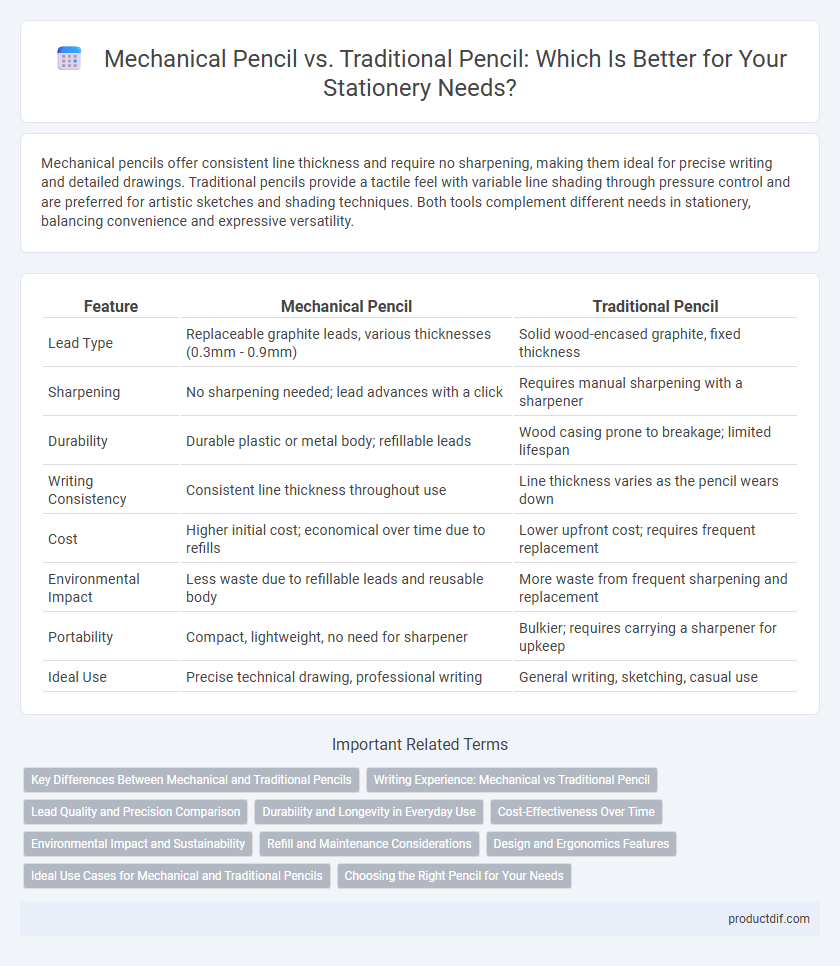Mechanical pencils offer consistent line thickness and require no sharpening, making them ideal for precise writing and detailed drawings. Traditional pencils provide a tactile feel with variable line shading through pressure control and are preferred for artistic sketches and shading techniques. Both tools complement different needs in stationery, balancing convenience and expressive versatility.
Table of Comparison
| Feature | Mechanical Pencil | Traditional Pencil |
|---|---|---|
| Lead Type | Replaceable graphite leads, various thicknesses (0.3mm - 0.9mm) | Solid wood-encased graphite, fixed thickness |
| Sharpening | No sharpening needed; lead advances with a click | Requires manual sharpening with a sharpener |
| Durability | Durable plastic or metal body; refillable leads | Wood casing prone to breakage; limited lifespan |
| Writing Consistency | Consistent line thickness throughout use | Line thickness varies as the pencil wears down |
| Cost | Higher initial cost; economical over time due to refills | Lower upfront cost; requires frequent replacement |
| Environmental Impact | Less waste due to refillable leads and reusable body | More waste from frequent sharpening and replacement |
| Portability | Compact, lightweight, no need for sharpener | Bulkier; requires carrying a sharpener for upkeep |
| Ideal Use | Precise technical drawing, professional writing | General writing, sketching, casual use |
Key Differences Between Mechanical and Traditional Pencils
Mechanical pencils offer consistent line thickness and eliminate the need for sharpening, making them ideal for precision tasks and extended use. Traditional pencils provide variable line width through pressure and sharpening, allowing for artistic shading and texture variations. While mechanical pencils use replaceable graphite leads, traditional pencils are entirely consumable, impacting durability and environmental considerations.
Writing Experience: Mechanical vs Traditional Pencil
Mechanical pencils provide a consistent line thickness and smooth writing experience due to their fine, uniform lead, ideal for precise drawing and note-taking. Traditional pencils offer variable line depth and texture by adjusting pressure and angle, creating a more tactile and expressive writing feel. The choice between mechanical and traditional pencils depends on whether users prioritize uniformity and convenience or versatility and organic feedback in writing.
Lead Quality and Precision Comparison
Mechanical pencils offer consistent lead diameter, enhancing precision for detailed writing and drawing tasks, while traditional pencils vary in sharpness requiring frequent sharpening to maintain accuracy. The high-quality graphite rods in mechanical pencils resist breakage and provide uniform lines, contrasting with traditional pencils whose lead can dull irregularly and cause inconsistent strokes. Professionals and artists prefer mechanical pencils for their reliable precision and fine control, making them ideal for technical work and intricate designs.
Durability and Longevity in Everyday Use
Mechanical pencils offer superior durability in everyday use due to their refillable lead and sturdy plastic or metal construction, reducing the need for frequent replacements compared to traditional wooden pencils. Traditional pencils wear down as the wood and graphite are gradually shaved away during sharpening, limiting their lifespan despite their biodegradability. The longevity of mechanical pencils makes them a cost-effective and environmentally friendlier option for continuous writing and drawing tasks.
Cost-Effectiveness Over Time
Mechanical pencils often provide greater cost-effectiveness over time due to their refillable lead, which reduces waste and the need for frequent replacement compared to traditional wooden pencils. Traditional pencils may seem cheaper initially but require constant sharpening and eventual replacement, increasing long-term expenses. Investing in quality mechanical pencils with durable barrels and readily available lead refills minimizes ongoing costs and enhances sustainability.
Environmental Impact and Sustainability
Mechanical pencils generate less waste over time due to their reusable design and replaceable leads, significantly reducing the consumption of wood compared to traditional pencils. Traditional pencils contribute to deforestation and produce more debris from frequent sharpening, impacting forest ecosystems. By opting for mechanical pencils, users support sustainable practices through extended product lifespans and minimized environmental footprint.
Refill and Maintenance Considerations
Mechanical pencils offer easy refill options with standardized lead sizes, reducing waste and eliminating the need for sharpening, which enhances convenience and long-term usability. Traditional pencils require regular sharpening that shortens their lifespan and generates wood shavings, necessitating frequent maintenance and proper disposal. The cost-effectiveness of mechanical pencil refills, combined with minimal maintenance, makes them a practical choice for consistent writing or drawing tasks.
Design and Ergonomics Features
Mechanical pencils offer precision-engineered barrels with ergonomic grips designed to reduce hand fatigue during extended use, featuring retractable tips and consistent line widths. Traditional pencils boast a simple wooden design that provides tactile feedback and natural grip variation, but often lack adjustable lengths and cushioning. Enhanced mechanical pencil designs emphasize lightweight materials and balanced weight distribution, improving comfort compared to the uniform, heavier feel of traditional wooden pencils.
Ideal Use Cases for Mechanical and Traditional Pencils
Mechanical pencils excel in precision tasks such as technical drawing, drafting, and detailed note-taking due to their consistent line width and convenience of not requiring sharpening. Traditional pencils are ideal for sketching, shading, and artistic work where variable line thickness and texture add depth and expression to the artwork. For everyday writing and casual use, traditional pencils offer versatility and tactile feedback that some users prefer over the uniformity of mechanical pencils.
Choosing the Right Pencil for Your Needs
Mechanical pencils offer consistent line precision and require less sharpening, making them ideal for detailed technical drawing and everyday writing tasks. Traditional pencils provide variable line thickness and a tactile feel, preferred for sketching, shading, and artistic expression. Selecting the right pencil depends on your primary use--mechanical pencils suit accuracy and convenience, while traditional pencils excel in versatility and creative flexibility.
Mechanical Pencil vs Traditional Pencil Infographic

 productdif.com
productdif.com